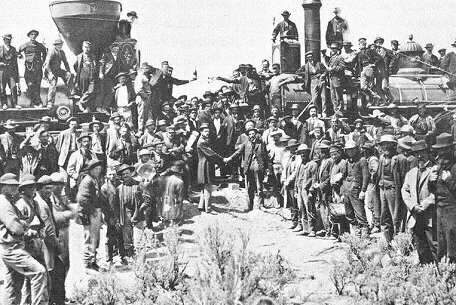In the days before Air Force One, U.S. presidents used train travel to extend the power of their office and make headlines.
 On the anniversary of the biggest event in train history—the driving of the Golden Spike on May 10, 1969, in Utah—here’s a look back at the symbolism and impact of railroad travel on the presidency.
On the anniversary of the biggest event in train history—the driving of the Golden Spike on May 10, 1969, in Utah—here’s a look back at the symbolism and impact of railroad travel on the presidency.
The linking of the Transcontinental Railroad was championed by Presidents Abraham Lincoln and Ulysses Grant. Lincoln signed the Pacific Railroad Act in 1862 with congressional backing, and few involved with the act probably understood the broad impact the railroad would have within a decade as it connected the nation for travel.
The impacted included the train as a symbol of political power and a tool on the campaign trail.
Here’s a look at some key moments involving presidents and trains.
1. William Henry Harrison, train pioneer. The first five presidents never set foot on a train. Harrison was the first presidential candidate to campaign using a train, when he ran unsuccessfully for office in 1836. Harrison used a train to travel to Washington after his win in 1840. (John Quincy Adams was the first to ride on a train.)
2. Abraham Lincoln, train trendsetter. Trains were associated with Lincoln in his national political career. One of his nicknames was the “rail splitter.” Lincoln famously used a long train trip as president-elect to gather support as he traveled to Washington in 1861 for his inauguration, but he had to divert in Baltimore after a rumored assassination attempt. Lincoln’s funeral train was also an iconic moment in American history.
3. James Garfield, probably not a train fan. President Garfield didn’t escape an assassination attempt at a train station. In July 1881, Garfield went to the Baltimore & Potomac Railroad Station in Washington without a security detail, as was the custom. Assassin Charles Guiteau shot the president twice. Garfield was about to board the train for a vacation. He died in September.
4. Warren Harding, more train troubles. In June 1923, a weakened Presdient Harding decided to take off on a westward voyage, most of which was by train, to rebuild his presidential image. Harding traveled on a train in Alaska; on another train trip heading toward San Francisco, his health condition worsened. Harding left his train and went to the Palace Hotel, where he died, likely from a heart attack.
5. FDR, rider of luxury (and secret) trains. President Franklin Roosevelt starting using a luxurious train called U.S. Car No. 1 in late 1942. It was the heaviest railroad car in the nation and had multiple conference rooms and bedrooms. U.S. Car No. 1 was also part of the funeral train for Roosevelt after he died. In later years, a hidden train for Roosevelt’s use was found in a long-unused station under the Waldorf Astoria Hotel in New York.
FYI, you can see U.S. Car No. 1 if you are in the Miami area: www.nps.gov/nr/travel/presidents/us_car_number_one.html
6. Harry Truman, trained train rider. Truman inherited U.S. Car No. 1 in 1945 and, as a former train industry employee, put it to good use. But he also wanted to run the train at 80 miles per hour, which was much faster than Roosevelt’s preferred speed of 25 miles per hour. Truman used U.S. Car No. 1 for his 1948 whistle-stop tour, and he stood on the back of the train holding up a “Dewey Defeats Truman” newspaper in that now-famous picture.
7. Trains are still presidential campaign symbols. President Eisenhower retired U.S. Car No. 1, but since then, presidents and candidates pop up on symbolic train trips on a regular basis. Presidents from Gerald Ford to Barack Obama have made train trips. Richard Nixon also campaigned on trains in the 1950s and 1960s. In 2009, then President-elect Obama traveled part of Lincoln’s inaugural route as a symbolic gesture on the way to his inauguration. He used the Georgia 300, a train built in 1930 and picked out by President George H.W. Bush in 1992 for campaigning.







